Early medieval period (mid 6th c.–1200 CE)
Early medieval India began after the end of the Gupta Empire in the 6th century CE.[137] This period also covers the "Late Classical Age" of Hinduism,[186] which began after the end of the Gupta Empire,[186] and the collapse of the Empire of Harsha in the 7th century CE;[186] the beginning of Imperial Kannauj, leading to the Tripartite struggle; and ended in the 13th century with the rise of the Delhi Sultanate in Northern India[187] and the end of the Later Cholas with the death of Rajendra Chola III in 1279 in Southern India; however some aspects of the Classical period continued until the fall of the Vijayanagara Empire in the south around the 17th century.
From the fifth century to the thirteenth, Śrauta sacrifices declined, and initiatory traditions of Buddhism, Jainism or more commonly Shaivism, Vaishnavism and Shaktism expanded in royal courts.[188] This period produced some of India's finest art, considered the epitome of classical development, and the development of the main spiritual and philosophical systems which continued to be in Hinduism, Buddhism and Jainism.
In the 7th century CE, Kumārila Bhaṭṭa formulated his school of Mimamsa philosophy and defended the position on Vedic rituals against Buddhist attacks. Scholars note Bhaṭṭa's contribution to the decline of Buddhism in India.[189] In the 8th century, Adi Shankara travelled across the Indian subcontinent to propagate and spread the doctrine of Advaita Vedanta, which he consolidated; and is credited with unifying the main characteristics of the current thoughts in Hinduism.[190][191][192] He was a critic of both Buddhism and Minamsa school of Hinduism;[193][194][195][196] and founded mathas (monasteries), in the four corners of the Indian subcontinent for the spread and development of Advaita Vedanta.[197] While, Muhammad bin Qasim's invasion of Sindh (modern Pakistan) in 711 CE witnessed further decline of Buddhism. The Chach Nama records many instances of conversion of stupas to mosques such as at Nerun.[198]
From the 8th to the 10th century, three dynasties contested for control of northern India: the Gurjara Pratiharas of Malwa, the Palas of Bengal, and the Rashtrakutas of the Deccan. The Sena dynasty would later assume control of the Pala Empire; the Gurjara Pratiharas fragmented into various states, notably the Paramaras of Malwa, the Chandelas of Bundelkhand, the Kalachuris of Mahakoshal, the Tomaras of Haryana, and the Chauhans of Rajputana, these states were some of the earliest Rajput kingdoms;[199] while the Rashtrakutas were annexed by the Western Chalukyas.[200] During this period, the Chaulukya dynasty emerged; the Chaulukyas constructed the Dilwara Temples, Modhera Sun Temple, Rani ki vav[201] in the style of Māru-Gurjara architecture, and their capital Anhilwara (modern Patan, Gujarat) was one of the largest cities in the Indian subcontinent, with the population estimated at 100,000 in 1000 CE.
The Chola Empire emerged as a major power during the reign of Raja Raja Chola I and Rajendra Chola I who successfully invaded parts of Southeast Asia and Sri Lanka in the 11th century.[202] Lalitaditya Muktapida (r. 724–760 CE) was an emperor of the Kashmiri Karkoṭa dynasty, which exercised influence in northwestern India from 625 CE until 1003, and was followed by Lohara dynasty. Kalhana in his Rajatarangini credits king Lalitaditya with leading an aggressive military campaign in Northern India and Central Asia.[203][204][205]
The Hindu Shahi dynasty ruled portions of eastern Afghanistan, northern Pakistan, and Kashmir from the mid-7th century to the early 11th century. While in Odisha, the Eastern Ganga Empire rose to power; noted for the advancement of Hindu architecture, most notable being Jagannath Temple and Konark Sun Temple, as well as being patrons of art and literature.
Chalukya Empire
The Chalukya Empire ruled large parts of southern and central India between the 6th and the 12th centuries. During this period, they ruled as three related yet individual dynasties. The earliest dynasty, known as the "Badami Chalukyas", ruled from Vatapi (modern Badami) from the middle of the 6th century. The Badami Chalukyas began to assert their independence at the decline of the Kadamba kingdom of Banavasi and rapidly rose to prominence during the reign of Pulakeshin II. The rule of the Chalukyas marks an important milestone in the history of South India and a golden age in the history of Karnataka. The political atmosphere in South India shifted from smaller kingdoms to large empires with the ascendancy of Badami Chalukyas. A Southern India-based kingdom took control and consolidated the entire region between the Kaveri and the Narmada rivers. The rise of this empire saw the birth of efficient administration, overseas trade and commerce and the development of new style of architecture called "Chalukyan architecture". The Chalukya dynasty ruled parts of southern and central India from Badami in Karnataka between 550 and 750, and then again from Kalyani between 970 and 1190.
Rashtrakuta Empire
Founded by Dantidurga around 753,[206] the Rashtrakuta Empire ruled from its capital at Manyakheta for almost two centuries.[207] At its peak, the Rashtrakutas ruled from the Ganges River and Yamuna River doab in the north to Cape Comorin in the south, a fruitful time of political expansion, architectural achievements and famous literary contributions.[208][209]
The early rulers of this dynasty were Hindu, but the later rulers were strongly influenced by Jainism.[210] Govinda III and Amoghavarsha were the most famous of the long line of able administrators produced by the dynasty. Amoghavarsha, who ruled for 64 years, was also an author and wrote Kavirajamarga, the earliest known Kannada work on poetics.[207][211] Architecture reached a milestone in the Dravidian style, the finest example of which is seen in the Kailasanath Temple at Ellora. Other important contributions are the Kashivishvanatha temple and the Jain Narayana temple at Pattadakal in Karnataka.
The Arab traveller Suleiman described the Rashtrakuta Empire as one of the four great Empires of the world.[212] The Rashtrakuta period marked the beginning of the golden age of southern Indian mathematics. The great south Indian mathematician Mahāvīra lived in the Rashtrakuta Empire and his text had a huge impact on the medieval south Indian mathematicians who lived after him.[213] The Rashtrakuta rulers also patronised men of letters, who wrote in a variety of languages from Sanskrit to the Apabhraṃśas.[207]
Gurjara-Pratihara Empire
The Gurjara-Pratiharas were instrumental in containing Arab armies moving east of the Indus River.[214] Nagabhata I defeated the Arab army under Junaid and Tamin during the Caliphate campaigns in India. Under Nagabhata II, the Gurjara-Pratiharas became the most powerful dynasty in northern India. He was succeeded by his son Ramabhadra, who ruled briefly before being succeeded by his son, Mihira Bhoja. Under Bhoja and his successor Mahendrapala I, the Pratihara Empire reached its peak of prosperity and power. By the time of Mahendrapala, the extent of its territory rivalled that of the Gupta Empire stretching from the border of Sindh in the west to Bihar in the east and from the Himalayas in the north to areas past the Narmada in the south.[215][verification needed] The expansion triggered a tripartite power struggle with the Rashtrakuta and Pala empires for control of the Indian subcontinent. During this period, Imperial Pratihara took the title of Maharajadhiraja of Āryāvarta (Great King of Kings of India).[citation needed]
By the 10th century, several feudatories of the empire took advantage of the temporary weakness of the Gurjara-Pratiharas to declare their independence, notably the Paramaras of Malwa, the Chandelas of Bundelkhand, the Kalachuris of Mahakoshal, the Tomaras of Haryana, and the Chauhans of Rajputana.
Gahadavala dynasty
Gahadavala dynasty ruled parts of the present-day Indian states of Uttar Pradesh and Bihar, during 11th and 12th centuries. Their capital was located at Varanasi in the Gangetic plains.[217]
Khayaravala dynasty
The Khayaravala dynasty, ruled parts of the present-day Indian states of Bihar and Jharkhand, during 11th and 12th centuries. Their capital was located at Khayaragarh in Shahabad district. Pratapdhavala and Shri Pratapa were king of the dynasty according to inscription of Rohtas.[218]
Pala Empire
The Pala Empire was founded by Gopala I.[219][220][221] It was ruled by a Buddhist dynasty from Bengal in the eastern region of the Indian subcontinent. The Palas reunified Bengal after the fall of Shashanka's Gauda Kingdom.[222]
The Palas were followers of the Mahayana and Tantric schools of Buddhism,[223] they also patronised Shaivism and Vaishnavism.[224] The morpheme Pala, meaning "protector", was used as an ending for the names of all the Pala monarchs. The empire reached its peak under Dharmapala and Devapala. Dharmapala is believed to have conquered Kanauj and extended his sway up to the farthest limits of India in the northwest.[224]
The Pala Empire can be considered as the golden era of Bengal in many ways.[225] Dharmapala founded the Vikramashila and revived Nalanda,[224] considered one of the first great universities in recorded history. Nalanda reached its height under the patronage of the Pala Empire.[225][226] The Palas also built many viharas. They maintained close cultural and commercial ties with countries of Southeast Asia and Tibet. Sea trade added greatly to the prosperity of the Pala Empire. The Arab merchant Suleiman notes the enormity of the Pala army in his memoirs.[224]
Cholas
Medieval Cholas rose to prominence during the middle of the 9th century CE and established the greatest empire South India had seen.[227] They successfully united the South India under their rule and through their naval strength extended their influence in the Southeast Asian countries such as Srivijaya.[202] Under Rajaraja Chola I and his successors Rajendra Chola I, Rajadhiraja Chola, Virarajendra Chola and Kulothunga Chola I the dynasty became a military, economic and cultural power in South Asia and South-East Asia.[228][229] Rajendra Chola I's navies went even further, occupying the sea coasts from Burma to Vietnam,[230] the Andaman and Nicobar Islands, the Lakshadweep (Laccadive) islands, Sumatra, and the Malay Peninsula in Southeast Asia and the Pegu islands. The power of the new empire was proclaimed to the eastern world by the expedition to the Ganges which Rajendra Chola I undertook and by the occupation of cities of the maritime empire of Srivijaya in Southeast Asia, as well as by the repeated embassies to China.[231]
They dominated the political affairs of Sri Lanka for over two centuries through repeated invasions and occupation. They also had continuing trade contacts with the Arabs in the west and with the Chinese empire in the east.[232] Rajaraja Chola I and his equally distinguished son Rajendra Chola I gave political unity to the whole of Southern India and established the Chola Empire as a respected sea power.[233] Under the Cholas, the South India reached new heights of excellence in art, religion and literature. In all of these spheres, the Chola period marked the culmination of movements that had begun in an earlier age under the Pallavas. Monumental architecture in the form of majestic temples and sculpture in stone and bronze reached a finesse never before achieved in India.[234]
Western Chalukya Empire
The Western Chalukya Empire ruled most of the western Deccan, South India, between the 10th and 12th centuries.[235] Vast areas between the Narmada River in the north and Kaveri River in the south came under Chalukya control.[235] During this period the other major ruling families of the Deccan, the Hoysalas, the Seuna Yadavas of Devagiri, the Kakatiya dynasty and the Southern Kalachuris, were subordinates of the Western Chalukyas and gained their independence only when the power of the Chalukya waned during the latter half of the 12th century.[236]
The Western Chalukyas developed an architectural style known today as a transitional style, an architectural link between the style of the early Chalukya dynasty and that of the later Hoysala empire. Most of its monuments are in the districts bordering the Tungabhadra River in central Karnataka. Well known examples are the Kasivisvesvara Temple at Lakkundi, the Mallikarjuna Temple at Kuruvatti, the Kallesvara Temple at Bagali, Siddhesvara Temple at Haveri, and the Mahadeva Temple at Itagi.[237] This was an important period in the development of fine arts in Southern India, especially in literature as the Western Chalukya kings encouraged writers in the native language of Kannada, and Sanskrit like the philosopher and statesman Basava and the great mathematician Bhāskara II.[238][239]
Late medieval period (c. 1200–1526 CE)
The late medieval period is marked by repeated invasions of the Muslim Central Asian nomadic clans,[240][241] the rule of the Delhi sultanate, and by the growth of other dynasties and empires, built upon military technology of the Sultanate.[242]
Delhi Sultanate
The Delhi Sultanate was a series of successive Islamic states based in Delhi, ruled by several dynasties of Turkic, Turko-Indian[244] and Pashtun origins.[245] It ruled large parts of the Indian subcontinent from the 13th century to the early 16th century.[246] In the 12th and 13th centuries, Central Asian Turks invaded parts of northern India and established the Delhi Sultanate in the former Hindu holdings.[247] The subsequent Mamluk dynasty of Delhi managed to conquer large areas of northern India, while the Khalji dynasty conquered most of central India while forcing the principal Hindu kingdoms of South India to become vassal states.[246]
The Sultanate ushered in a period of Indian cultural renaissance. The resulting "Indo-Muslim" fusion of cultures left lasting syncretic monuments in architecture, music, literature, religion, and clothing. It is surmised that the language of Urdu was born during the Delhi Sultanate period as a result of the intermingling of the local speakers of Sanskritic Prakrits with immigrants speaking Persian, Turkic, and Arabic under the Muslim rulers. The Delhi Sultanate is the only Indo-Islamic empire to enthrone one of the few female rulers in India, Razia Sultana (1236–1240).
During the Delhi Sultanate, there was a synthesis between Indian civilisation and Islamic civilisation[citation needed]. The latter was a cosmopolitan civilisation, with a multicultural and pluralistic society, and wide-ranging international networks, including social and economic networks, spanning large parts of Afro-Eurasia, leading to escalating circulation of goods, peoples, technologies and ideas. While initially disruptive due to the passing of power from native Indian elites to Turkic Muslim elites, the Delhi Sultanate was responsible for integrating the Indian subcontinent into a growing world system, drawing India into a wider international network, which had a significant impact on Indian culture and society.[248] However, the Delhi Sultanate also caused large-scale destruction and desecration of temples in the Indian subcontinent.[249]
The Mongol invasions of India were successfully repelled by the Delhi Sultanate during the rule of Alauddin Khalji. A major factor in their success was their Turkic Mamluk slave army, who were highly skilled in the same style of nomadic cavalry warfare as the Mongols, as a result of having similar nomadic Central Asian roots. It is possible that the Mongol Empire may have expanded into India were it not for the Delhi Sultanate's role in repelling them.[250] By repeatedly repulsing the Mongol raiders, the sultanate saved India from the devastation visited on West and Central Asia, setting the scene for centuries of migration of fleeing soldiers, learned men, mystics, traders, artists, and artisans from that region into the subcontinent, thereby creating a syncretic Indo-Islamic culture in the north.[251][250]
A Turco-Mongol conqueror in Central Asia, Timur (Tamerlane), attacked the reigning Sultan Nasir-u Din Mehmud of the Tughlaq dynasty in the north Indian city of Delhi.[252] The Sultan's army was defeated on 17 December 1398. Timur entered Delhi and the city was sacked, destroyed, and left in ruins after Timur's army had killed and plundered for three days and nights. He ordered the whole city to be sacked except for the sayyids, scholars, and the "other Muslims" (artists); 100,000 war prisoners were put to death in one day.[253] The Sultanate suffered significantly from the sacking of Delhi. Though revived briefly under the Lodi dynasty, it was but a shadow of the former.
Vijayanagara Empire
The Vijayanagara Empire was established in 1336 by Harihara I and his brother Bukka Raya I of Sangama Dynasty,[254] which originated as a political heir of the Hoysala Empire, Kakatiya Empire,[255] and the Pandyan Empire.[256] The empire rose to prominence as a culmination of attempts by the south Indian powers to ward off Islamic invasions by the end of the 13th century. It lasted until 1646, although its power declined after a major military defeat in 1565 by the combined armies of the Deccan sultanates. The empire is named after its capital city of Vijayanagara, whose ruins surround present day Hampi, now a World Heritage Site in Karnataka, India.[257]
In the first two decades after the founding of the empire, Harihara I gained control over most of the area south of the Tungabhadra river and earned the title of Purvapaschima Samudradhishavara ("master of the eastern and western seas"). By 1374 Bukka Raya I, successor to Harihara I, had defeated the chiefdom of Arcot, the Reddys of Kondavidu, and the Sultan of Madurai and had gained control over Goa in the west and the Tungabhadra-Krishna River doab in the north.[258][259]
With the Vijayanagara Kingdom now imperial in stature, Harihara II, the second son of Bukka Raya I, further consolidated the kingdom beyond the Krishna River and brought the whole of South India under the Vijayanagara umbrella.[260] The next ruler, Deva Raya I, emerged successful against the Gajapatis of Odisha and undertook important works of fortification and irrigation.[261] Italian traveler Niccolo de Conti wrote of him as the most powerful ruler of India.[262] Deva Raya II (called Gajabetekara)[263] succeeded to the throne in 1424 and was possibly the most capable of the Sangama Dynasty rulers.[264] He quelled rebelling feudal lords as well as the Zamorin of Calicut and Quilon in the south. He invaded the island of Sri Lanka and became overlord of the kings of Burma at Pegu and Tanasserim.[265][266][267]
The Vijayanagara Emperors were tolerant of all religions and sects, as writings by foreign visitors show.[268] The kings used titles such as Gobrahamana Pratipalanacharya (literally, "protector of cows and Brahmins") and Hindurayasuratrana (lit, "upholder of Hindu faith") that testified to their intention of protecting Hinduism and yet were at the same time staunchly Islamicate in their court ceremonials and dress.[269] The empire's founders, Harihara I and Bukka Raya I, were devout Shaivas (worshippers of Shiva), but made grants to the Vaishnava order of Sringeri with Vidyaranya as their patron saint, and designated Varaha (the boar, an Avatar of Vishnu) as their emblem.[270] Over one-fourth of the archaeological dig found an "Islamic Quarter" not far from the "Royal Quarter". Nobles from Central Asia's Timurid kingdoms also came to Vijayanagara. The later Saluva and Tuluva kings were Vaishnava by faith, but worshipped at the feet of Lord Virupaksha (Shiva) at Hampi as well as Lord Venkateshwara (Vishnu) at Tirupati. A Sanskrit work, Jambavati Kalyanam by King Krishnadevaraya, called Lord Virupaksha Karnata Rajya Raksha Mani ("protective jewel of Karnata Empire").[271][full citation needed] The kings patronised the saints of the dvaita order (philosophy of dualism) of Madhvacharya at Udupi.[272]
The empire's legacy includes many monuments spread over South India, the best known of which is the group at Hampi. The previous temple building traditions in South India came together in the Vijayanagara Architecture style. The mingling of all faiths and vernaculars inspired architectural innovation of Hindu temple construction, first in the Deccan and later in the Dravidian idioms using the local granite. South Indian mathematics flourished under the protection of the Vijayanagara Empire in Kerala. The south Indian mathematician Madhava of Sangamagrama founded the famous Kerala School of Astronomy and Mathematics in the 14th century which produced a lot of great south Indian mathematicians like Parameshvara, Nilakantha Somayaji and Jyeṣṭhadeva in medieval south India.[275] Efficient administration and vigorous overseas trade brought new technologies such as water management systems for irrigation.[276] The empire's patronage enabled fine arts and literature to reach new heights in Kannada, Telugu, Tamil, and Sanskrit, while Carnatic music evolved into its current form.[277]
Vijayanagara went into decline after the defeat in the Battle of Talikota (1565). After the death of Aliya Rama Raya in the Battle of Talikota, Tirumala Deva Raya started the Aravidu dynasty, moved and founded a new capital of Penukonda to replace the destroyed Hampi, and attempted to reconstitute the remains of Vijayanagara Empire.[278] Tirumala abdicated in 1572, dividing the remains of his kingdom to his three sons, and pursued a religious life until his death in 1578. The Aravidu dynasty successors ruled the region but the empire collapsed in 1614, and the final remains ended in 1646, from continued wars with the Bijapur sultanate and others.[279][280][281] During this period, more kingdoms in South India became independent and separate from Vijayanagara. These include the Mysore Kingdom, Keladi Nayaka, Nayaks of Madurai, Nayaks of Tanjore, Nayakas of Chitradurga and Nayak Kingdom of Gingee – all of which declared independence and went on to have a significant impact on the history of South India in the coming centuries.[282]
Kingdom of Mewar (c. 728–1949 CE)
For two and a half centuries from the mid-13th century, politics in Northern India was dominated by the Delhi Sultanate, and in Southern India by the Vijayanagar Empire. However, there were other regional powers present as well. After fall of Pala Empire, the Chero dynasty ruled much of Eastern Uttar Pradesh, Bihar and Jharkhand from 12th CE to 18th CE.[283][284][285] The Reddy dynasty successfully defeated the Delhi Sultanate; and extended their rule from Cuttack in the north to Kanchi in the south, eventually being absorbed into the expanding Vijayanagara Empire.[286]
In the north, the Rajput kingdoms remained the dominant force in Western and Central India. The Mewar dynasty under Maharana Hammir defeated and captured Muhammad Tughlaq with the Bargujars as his main allies. Tughlaq had to pay a huge ransom and relinquish all of Mewar's lands. After this event, the Delhi Sultanate did not attack Chittor for a few hundred years. The Rajputs re-established their independence, and Rajput states were established as far east as Bengal and north into the Punjab. The Tomaras established themselves at Gwalior, and Man Singh Tomar reconstructed the Gwalior Fort which still stands there.[287] During this period, Mewar emerged as the leading Rajput state; and Rana Kumbha expanded his kingdom at the expense of the Sultanates of Malwa and Gujarat.[287][288] The next great Rajput ruler, Rana Sanga of Mewar, became the principal player in Northern India. His objectives grew in scope – he planned to conquer the much sought after prize of the Muslim rulers of the time, Delhi. But, his defeat in the Battle of Khanwa consolidated the new Mughal dynasty in India.[287] The Mewar dynasty under Maharana Udai Singh II faced further defeat by Mughal emperor Akbar, with their capital Chittor being captured. Due to this event, Udai Singh II founded Udaipur, which became the new capital of the Mewar kingdom. His son, Maharana Pratap of Mewar, firmly resisted the Mughals. Akbar sent many missions against him. He survived to ultimately gain control of all of Mewar, excluding the Chittor Fort.[289]
In the south, the Bahmani Sultanate, which was established either by a Brahman convert or patronised by a Brahman and from that source it was given the name Bahmani,[290] was the chief rival of the Vijayanagara, and frequently created difficulties for the Vijayanagara.[291] In the early 16th century Krishnadevaraya of the Vijayanagar Empire defeated the last remnant of Bahmani Sultanate power. After which, the Bahmani Sultanate collapsed,[292] resulting it being split into five small Deccan sultanates.[293] In 1490, Ahmadnagar declared independence, followed by Bijapur and Berar in the same year; Golkonda became independent in 1518 and Bidar in 1528.[294] Although generally rivals, they did ally against the Vijayanagara Empire in 1565, permanently weakening Vijayanagar in the Battle of Talikota.
In the East, the Gajapati Kingdom remained a strong regional power to reckon with, associated with a high point in the growth of regional culture and architecture. Under Kapilendradeva, Gajapatis became an empire stretching from the lower Ganga in the north to the Kaveri in the south.[295] In Northeast India, the Ahom Kingdom was a major power for six centuries;[296][297] led by Lachit Borphukan, the Ahoms decisively defeated the Mughal army at the Battle of Saraighat during the Ahom-Mughal conflicts.[298] Further east in Northeastern India was the Kingdom of Manipur, which ruled from their seat of power at Kangla Fort and developed a sophisticated Hindu Gaudiya Vaishnavite culture.[299][300][301]
The Sultanate of Bengal was the dominant power of the Ganges–Brahmaputra Delta, with a network of mint towns spread across the region. It was a Sunni Muslim monarchy with Indo-Turkic, Arab, Abyssinian and Bengali Muslim elites. The sultanate was known for its religious pluralism where non-Muslim communities co-existed peacefully. The Bengal Sultanate had a circle of vassal states, including Odisha in the southwest, Arakan in the southeast, and Tripura in the east. In the early 16th century, the Bengal Sultanate reached the peak of its territorial growth with control over Kamrup and Kamata in the northeast and Jaunpur and Bihar in the west. It was reputed as a thriving trading nation and one of Asia's strongest states.The Bengal Sultanate was described by contemporary European and Chinese visitors as a relatively prosperous kingdom. Due to the abundance of goods in Bengal, the region was described as the "richest country to trade with". The Bengal Sultanate left a strong architectural legacy. Buildings from the period show foreign influences merged into a distinct Bengali style. The Bengal Sultanate was also the largest and most prestigious authority among the independent medieval Muslim-ruled states in the history of Bengal. Its decline began with an interregnum by the Suri Empire, followed by Mughal conquest and disintegration into petty kingdoms.
Bhakti movement and Sikhism
The Bhakti movement refers to the theistic devotional trend that emerged in medieval Hinduism[302] and later revolutionised in Sikhism.[303] It originated in the seventh-century south India (now parts of Tamil Nadu and Kerala), and spread northwards.[302] It swept over east and north India from the 15th century onwards, reaching its zenith between the 15th and 17th century CE.[304]
- The Bhakti movement regionally developed around different gods and goddesses, such as Vaishnavism (Vishnu), Shaivism (Shiva), Shaktism (Shakti goddesses), and Smartism.[305][306][307] The movement was inspired by many poet-saints, who championed a wide range of philosophical positions ranging from theistic dualism of Dvaita to absolute monism of Advaita Vedanta.[308][309]
- Sikhism is based on the spiritual teachings of Guru Nanak, the first Guru,[310] and the ten successive Sikh gurus. After the death of the tenth Guru, Guru Gobind Singh, the Sikh scripture, Guru Granth Sahib, became the literal embodiment of the eternal, impersonal Guru, where the scripture's word serves as the spiritual guide for Sikhs.[311][312][313]
- Buddhism in India flourished in the Himalayan kingdoms of Namgyal Kingdom in Ladakh, Sikkim Kingdom in Sikkim, and Chutia Kingdom in Arunachal Pradesh of the Late medieval period.
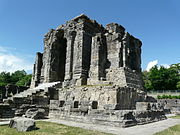

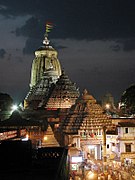




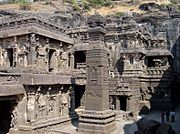

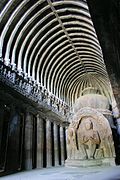

![One of the four entrances of the Teli ka Mandir. This Hindu temple was built by the Pratihara emperor Mihira Bhoja.[216]](https://upload.wikimedia.org/wikipedia/commons/thumb/6/64/Teli_ka_Mandir_%2815702266503%29.jpg/135px-Teli_ka_Mandir_%2815702266503%29.jpg)





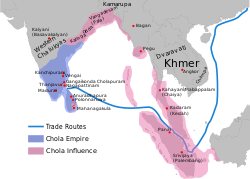







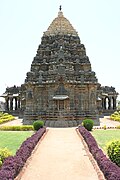
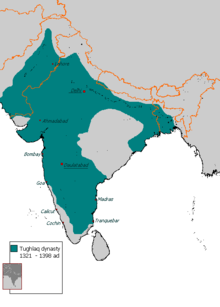

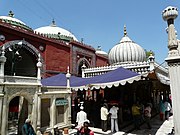
![The grave of Razia, the Sultana of Delhi, from 1236 CE to 1240 CE, the only female ruler of a major realm on the Indian subcontinent until modern times.[citation needed]](https://upload.wikimedia.org/wikipedia/commons/thumb/5/5a/Tomb_of_Razia_Sultana_001.jpg/180px-Tomb_of_Razia_Sultana_001.jpg)



![An 1868 photograph of the ruins of the Vijayanagara Empire at Hampi, now a UNESCO World Heritage Site[273]](https://upload.wikimedia.org/wikipedia/commons/thumb/9/9e/Ruins_of_Bala_Krishna_Temple_Vijayanagara_Hampi_1868_Edmund_Lyon_photo.jpg/180px-Ruins_of_Bala_Krishna_Temple_Vijayanagara_Hampi_1868_Edmund_Lyon_photo.jpg)
![Gajashaala or elephant's stable, built by the Vijayanagar rulers for their war elephants.[274]](https://upload.wikimedia.org/wikipedia/commons/thumb/6/63/Elephant%27s_stable_or_Gajashaale.JPG/180px-Elephant%27s_stable_or_Gajashaale.JPG)



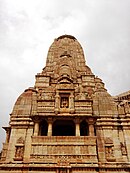




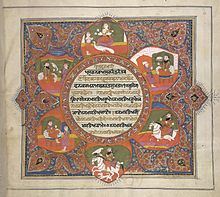




Comments
Post a Comment